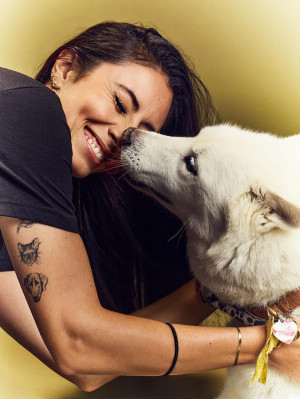New Research Finds a Dog’s Size Impacts Their Disease Risk
A study finds small and large dogs have their own unique set of health concerns.

share article
It’s fairly common knowledge that, generally, large dogs have a shorter lifespan than small dogs (though scientists are on the caseopens in a new tab to keep those gentle giants with us longer). “Small dog breeds, such as Shih Tzu, Chihuahuas, Dachshunds, and Toy Poodles, may often live into their teens or even early twenties,” veterinarian Dr. Athena Gaffud tells The Wildest. “On the other hand, larger breeds, such as Mastiffs, Great Danes, Saint Bernards, and Great Pyrenees, may have average lifespans ranging from six to twelve years.”
A new study dives into the disease differences between small and large dogs — and the results aren’t as simple as you might expect. It turns out, large dogs aren’t more susceptible to all diseases; dogs of all different sizes have their own health issues to look out for.
The studyopens in a new tab, Dog size and patterns of disease history across the canine age spectrum, was helmed by the Dog Aging Projectopens in a new tab (DAP), a massive undertaking to improve the lives of senior pups that is tragically at risk of losing its fundingopens in a new tab. Since 2018, almost 50,000 dogs have been registered to the DAP’s database; every year, the pup parents of these dogs fill out a survey on their dogs’ health and life experiences.
For this study, the DAP analyzed their database to discover links between dog size and disease risk. “Age is the single greatest predictor of disease risk for most causes of mortality in both human and dog populations. However, for many dog diseases, body size is a comparably important predictor of risk,” wrote Yunbi Nam, the paper’s first author.
Researchers analyzed 27,541 surveys from dog parents. They collected information on body size (measured by weight), other demographics such as sex and age, and disease history. Pet parents were able to describe any specific condition their pup has been diagnosed with. In the end, researchers focused on thirteen categories of disease, which were reported in over 500 dogs: skin disorders, infectious or parasitic disease, orthopedic, gastrointestinal, ocular, ear/nose/throat (ENT), kidney/urinary, cancer, cardiac, neurologic, liver/pancreas, respiratory, and endocrine disorders.
Large dogs are at a greater risk for some diseases.
Researchers found that when it came to disease, there were major differences in the risks of small and large dogs:
Large dogs were more likely to experience skin disease (26 percent in dogs under 10 kilograms and 33 percent in dogs over 40 kilograms) — toy dogs had the lowest rates.
The very smallest dogs had the lowest risk of infectious disease, but “all other size classes were similar to each other, with 27 to 30 percent lifetime prevalence.”
When it comes to orthopedic conditions, there was little difference between small and large dogs when they were young — but after the age of seven, large dogs had a much higher risk.
Ear/nose/throat issues were more common in large dogs as puppies, but equally common among different sizes in senior years.
Large dogs are also slightly more likely to experience gastrointestinal problems and neurological disorders.
Cancer is also more common in large dogs, especially in senior years.
But small dogs have their own problems, too.
Large dogs weren’t at a higher risk of all diseases, though. In some cases, small dogs are actually more susceptible.
In the case of ocular conditions, dogs of different sizes have about the same risk — until their senior years, when small dogs have higher rates of disease (17 percent in dogs under 10 kilograms and 10 percent in dogs larger than 40 kilograms).
Lifetime prevalence of kidney disease is also higher in small dogs (9 percent in dogs under 10 kilograms and 6 percent in dogs larger than 40 kilograms).
Cardiac conditions were highly correlated with dog size, with small dogs having much higher risk. Dogs under 10 kilograms reported an 11 percent lifetime prevalence, while only two percent of dogs over 40 kilograms reported the same.
Liver and pancreas conditions were found to be less common among larger dogs, and so were respiratory conditions.
What are the next steps?
Researchers note that they can’t provide any proof of causation with the data they have acquired. They are still not sure what causes these disease differences in dogs, but they know they differ notably between dogs of different sizes. “These results nonetheless provide insights into the disease categories that may contribute to reduced lifespan in larger dogs and suggest multiple avenues for further exploration,” wrote Nam.
Dr. Gaffud points out that, for pet parents, there are ways to keep a pup as safe from disease as possible, regardless of their size or breed. “Pet parents help keep their pets safe from health problems through regular veterinary check-ups, a balanced dietopens in a new tab, proper exerciseopens in a new tab, dental careopens in a new tab, parasite preventionopens in a new tab, spaying and neuteringopens in a new tab, regular groomingopens in a new tab, mental stimulationopens in a new tab, and attention to a dog's overall well-being,” she says. “Responsible breeding practices and early detection of potential health issues can also contribute to better overall health in all dog breeds.”
The Dog Aging Project hopes to collect more data on dog disease to further explore the question of disease prevalence across dog sizes, with the aim that this knowledge will help veterinarians prevent disease in pups. If you would like to support the Dog Aging Project’s continuation, you can sign a petition hereopens in a new tab or donate to the founders’ new non-profit hereopens in a new tab.

Sio Hornbuckle
Sio Hornbuckle is a writer living in New York City with their cat, Toni Collette.
Related articles
![Celine Halioua, the founder of Loyal.]() opens in a new tab
opens in a new tabA New Drug Could Make Your Dog Live Longer—Meet the Woman Who Created It
The founder and CEO of Loyal, Celine Halioua, tells The Wildest what the future of pet parenthood could look like, starting with more time with your pup.
![A senior white dog with arthritis wearing a red collar standing by a large tree in the grass outside]() opens in a new tab
opens in a new tabMedication For Dog Arthritis: Dog Arthritis Pain Management
Hope for dogs with arthritis is on the horizon.
![Cute girl and huge black great dane face to face in front of window at morning time.]() opens in a new tab
opens in a new tabA New Drug Aims to Extend the Life Expectancy of Large Dogs
The FDA determined it has a “reasonable expectation of effectiveness.”
![golden retriever dog looks out window]() opens in a new tab
opens in a new tabCancer in Dogs: A Primer on Canine Cancers
The word cancer can set alarm bells, turn down the volume by brushing up on cancer basics.
![Brown Labrador lifting front leg]() opens in a new tab
opens in a new tabHow to Get a Head Start on Your Pet’s Health
Spot lumps, limps, and lethargy early on.
![woman with red hair holds senior Pomeranian dog]() opens in a new tab
opens in a new tabHow to Take Care of a Senior Dog
As dogs age, it’s important to recognize both physical and mental changes they may be experiencing.







